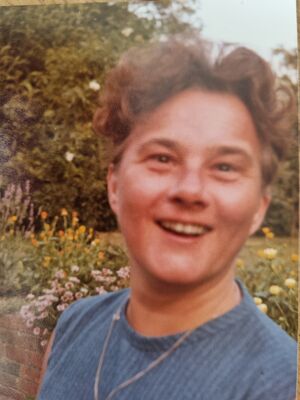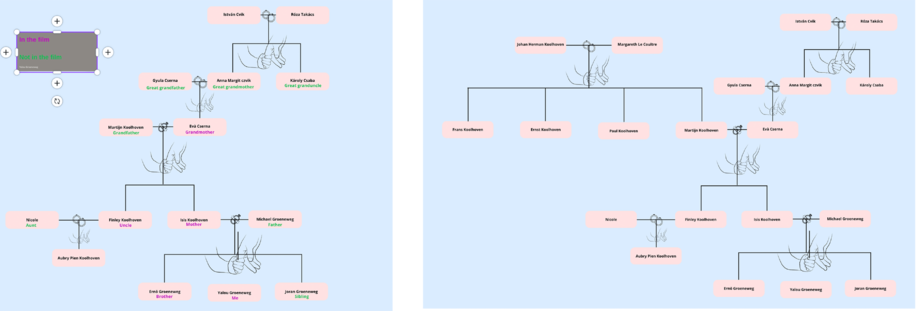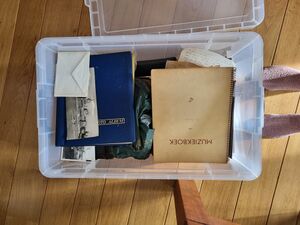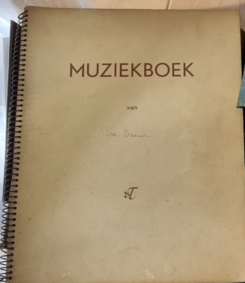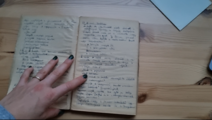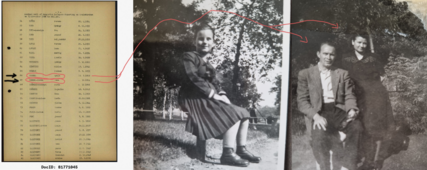Project proposal Yalou
Version number 1
Yalou's Draft Project Proposal
Final version
Steve's feedback 6 Nov
[Steve notes. The 'free writing' you do here is very evocative, below I have made a cut and paste of how it could be, using elements you wrote in previous versions. Please place the images ahead of our meeting on Thursday. Please also give the reader access to the experiments you showed at the last GRS sessions (the video 'prototypes' you have made; the tree drawing, the family tree material &c.) All of these elements show that this is a work that is already underway and there is a lot of supporting material already. It is great to see you developing a personal mode of address in the proposal text, and it will be exciting to extend this into the thesis. The 'dream' narrative helps us travel through time and space. The project is already very visually rich. It would be great to see this reflected in the proposal, with links to the material and the experiments you have made so far. Plenty to talk about on Thursday. It's progressing well.]
[title] is a documentary about my grandmother’s life and how her past has influenced her adult life, and how that influence is passed through generations. With the main voice her written piano music.
The documentary contains a variety of archive material: video, audio, photographs, letters/writings, music, jewellery and silverware. And I will combine this archive with new recorded film footage.
I choose this material because it will explain the meaning of passing on through generations, but it will also visualise my grandmother and her world.
My grandmothers music will be used as one of the most important voices in the film, as it connects to her life and it bridges to the present day. Where music is still one of the most important things in the family.
The soundtrack will be the piano music of my grandmother, performed by my brother and me. Not only will it be used as an emotional tool within the film but it will also represent voices and a bridge between then and now.
We are standing in an empty space, a field.
With in the middle a recognisable box. It is filled with the passed. A selected passed that my mother has told me about. This box once belonged to my grandmother, and she was the keeper of the content. I open the box and I start spreading the content across the field. And I soon discover that this content is my grandmothers archive and my grandmothers life story.
[S: Do you mean past? Or have you decided to use passed?]
*image of the variety of content*
It started with a lot of images of my grandmother Evà as a young girl, and on the back of the images there was some information about it. I even found an old high school note book. I could not read what was in it, as my grandmother is originally from Hungary. Let me tell you about that.
“Evà was born on the 4th of may in Budapest, Hungary. She was an only child. I was told that the first 4 years of her life were spend in mines because of WW2. But in 1956 she had to flee the country because of the Hungarian revolution together with her mother and father.”
While spreading the content I start to recognise resemblances. It started with physical resemblances.
[Suggest: spreading the content out, I recognise resemblances.]
*images of physical resemblances*
After some time and much more spreading, I began to see a diversity of resemblances. Not only in appearance but also in voice sounds, movements and behaviour.
[<You change tense here. Begin?]
The box was half empty and the open field was decorated with parts of my grandmother. All of a sudden I see a piano book, with my grandmothers name on it
[<Is decorated?]
“Evà”
*image of the piano book*
“She was a piano teacher” a voice says behind me. I jump from scare and turn around. It is my mother who smiles at me and looks a little concerned at the mess that I made.
Before I can say anything my mother starts telling about my grandmother.
[<Suggest: My mother tells me about my grandmother]
“Grandmother Evà has always loved music, from a very young age. It all started when she was a very young child. She wanted to become a dancer. But at the age of 9 she got diagnosed with polio. So even walking became a difficult task for her. Her connection to music has always stayed and I think that becoming a piano teacher was a way to keep on dancing. Not with her legs, but just her hands. I remember her playing almost daily. Music was a part of daily life. And not only for grandmother Evà but also for me and your uncle Finley. We both had to practice an instrument and any mistake would be heard by grandmother Evà. Back then music wasn’t as fun for me as it is now in our family. It was more a must than a want. But even though grandmother Evà passed away. The music never left the family.”
*images of all the musical instruments*
I nodded excited and looked in the distance at our family tree. It was standing at the edge of the open field and the tree was filled with instruments.
[I nod?]
*image of the family tree with instruments*
As I opened up the piano book, my mum was starting to walk home (to the family tree). Even though I couldn't really call the hopping and shuffling walking, it was quite difficult not to stand on the archive material.
I turned back to the piano book and started to recognise a lot of repetition. As if she wrote it down for someone else to practice. This was another fascinating finding for me, and I could connect it to the different resemblance that I had already found.
Everything is spread out on the open field.
An I ask myself why this is so interesting to me?
For me it is my grandmothers presence now a day and the life she lived. From being born in Hungary, getting polio at a young age, fleeing to The Netherlands at the age of seventeen and starting a new life there. This story must have grown into a traumatic experience. As her mental state changed later on in life. She became more bitter, sad and frustrated. This is even visible in the archive that she left behind. And that brings me to the next interesting question. Why did she leave this archive behind? Could it be a message from her?
*Images of the angry letters and the cut up pictures*
This all brings me to the now. What of her is here? I see it in my mom and I see it in my uncle. They carry the trauma and they are more similar to Evà than they think. But I also see it in me. And this repetition that is literally visible and literally hearable is about passing on to later generations.
How do we become part of the past?
It is already in us.
Previous Feedback by Steve
Things to do> work on this intro. A series of short film pieces
using the family archive with particular attention to my grandmother's music; (which in one piecve will be performed by will performed by members of the family.
My grandmother's presence is alive to this day. The project works with an archive that shows the story of my grandmother; how one generation influences another (in this case passing a world view down the generations), through acts of repetition which are expressed in the piece through repetition in behaviour and through repetition of visual traits).
[It works well to bring the reader back to the field, to situate the reader in your imaginative space. It is great that the text is in the mode of address of a memoir. I like the way it unfolds, but the beggining needs to be tighter.
The proposal is a very practical document so in the first few sentences the reader will get a good idea of what you propose. The current draft is thin on material information at the start, where it is most useful. Please answer these questions
What will you project be? Is it a film? An instillation? (one sentence)
What will it be made of? Found footage? Archive material? (one sentence) If so, what archive material?(one sentence)
Why have you chosen this material? (one sentence)
Will there be a text with the film? What form will this take? (one sentence)
What part does your grandmother's music play in the proposed piece? (one sentence)
What do you want to do with the soundtrack? (one sentence)
Answering these questions at the beginning helps the reader understand what you want to do (I know these elements are covered later in the proposal in some detail, but they need to be at the front). Once we know this your motivation makes sense so the proposal can continue in a more "poetic" fashion:]
Yalou's reaction on the feedback of Steve
After the past week(s) It has become much more clear what direction I want to go into. And I sure agree that the intro needs to be short and clear!
> A series of short film pieces still sounds amazing to me, but I am also interested in the documentary as 1 film. So maybe I will have space and time to do both. The most important aspect of the film is dat there is a clear narrative and that the viewer can connect to this narrative.
> The music of my grandmother is still as important as it was, and I am trying to think of a way how that can be a more clear narrative. And how this element is also visible as the voice of the film.
> The repetition and the generational passing is still a strong element in the work. I do want to specify this more, as I have been thinking about it a lot. In my first text on practice and in many conversations I speak often about her presence now a day. This feeling of her presence is a connection to this generational passing and this repetition but I also feel that it has a lot to do with generational trauma. A new subject in my work, but one that has already been visible for a long time. So the generational trauma connects to this repetition and this passing through generations.
> My project proposal will start with a clear and short introduction, where I will answer the following questions:
What will you project be? Is it a film? An instillation? (one sentence)
What will it be made of? Found footage? Archive material? (one sentence) If so, what archive material?(one sentence)
Why have you chosen this material? (one sentence)
Will there be a text with the film? What form will this take? (one sentence)
What part does your grandmother's music play in the proposed piece? (one sentence)
What do you want to do with the soundtrack? (one sentence)
> After the introduction is clear, I can indeed talk in a more metaphorical way.
The answer to the questions:
What will you project be? Is it a film? An instillation? (one sentence)
What will it be made of? Found footage? Archive material? (one sentence) If so, what archive material?(one sentence)
Why have you chosen this material? (one sentence)
Will there be a text with the film? What form will this take? (one sentence)
What part does your grandmother's music play in the proposed piece? (one sentence)
What do you want to do with the soundtrack? (one sentence)
A documentary about my grandmother’s life and how her past has influenced her adult life, and how that influence is passed through generations. With the main voice her written piano music.
The documentary contains a variety of archive material: video, audio, photographs, letters/writings, music, jewellery and silverware. And I will combine this archive with new recorded film footage.
I choose this material because it will explain the meaning of passing on through generations, but it will also visualise my grandmother and her world.
My grandmothers music will be used as one of the most important voices in the film, as it connects to her life and it bridges to the present day. Where music is still one of the most important things in the family.
The soundtrack will be the piano music of my grandmother, composed by my brother and me. Not only will it be used as an emotional tool within the film but it will also represent voices and a bridge between then and now.
Free writing (prototype)
Start writing a similar piece but more focus on the important elements within the project
We are standing in an empty space, a field.
With in the middle a recognisable box. It is filled with the passed. A selected passed that my mother has told me about. This box once belonged to my grandmother, and she was the keeper of the content. I open the box and I start spreading the content across the field. And I soon discover that this content is my grandmothers archive and my grandmothers life story.
*image of the variety of content*
It started with a lot of images of my grandmother Evà as a young girl, and on the back of the images there was some information about it. I even found an old high school note book. I could not read what was in it, as my grandmother is originally from Hungary. Let me tell you about that.
“Evà was born on the 4th of may in Budapest, Hungary. She was an only child. I was told that the first 4 years of her life were spend in mines because of WW2. But in 1956 she had to flee the country because of the Hungarian revolution together with her mother and father.”
While spreading the content I start to recognise resemblances. It started with physical resemblances.
*images of physical resemblances*
After some time and much more spreading, I began to see a diversity of resemblances. Not only in appearance but also in voice sounds, movements and behaviour.
The box was half empty and the open field was decorated with parts of my grandmother. All of a sudden I see a piano book, with my grandmothers name on it
“Evà”
*image of the piano book*
“She was a piano teacher” a voice says behind me. I jump from scare and turn around. It is my mother who smiles at me and looks a little concerned at the mess that I made.
Before I can say anything my mother starts telling about my grandmother.
“Grandmother Evà has always loved music, from a very young age. It all started when she was a very young child. She wanted to become a dancer. But at the age of 9 she got diagnosed with polio. So even walking became a difficult task for her. Her connection to music has always stayed and I think that becoming a piano teacher was a way to keep on dancing. Not with her legs, but just her hands. I remember her playing almost daily. Music was a part of daily life. And not only for grandmother Evà but also for me and your uncle Finley. We both had to practice an instrument and any mistake would be heard by grandmother Evà. Back then music wasn’t as fun for me as it is now in our family. It was more a must than a want. But even though grandmother Evà passed away. The music never left the family.”
*images of all the musical instruments*
I nodded excited and looked in the distance at our family tree. It was standing at the edge of the open field and the tree was filled with instruments.
*image of the family tree with instruments*
As I opened up the piano book, my mum was starting to walk home (to the family tree). Even though I couldn't really call the hopping and shuffling walking, it was quite difficult not to stand on the archive material.
I turned back to the piano book and started to recognise a lot of repetition. As if she wrote it down for someone else to practice. This was another fascinating finding for me, and I could connect it to the different resemblance that I had already found.
Everything is spread out on the open field.
An I ask myself why this is so interesting to me?
For me it is my grandmothers presence now a day and the life she lived. From being born in Hungary, getting polio at a young age, fleeing to The Netherlands at the age of seventeen and starting a new life there. This story must have grown into a traumatic experience. As her mental state changed later on in life. She became more bitter, sad and frustrated. This is even visible in the archive that she left behind. And that brings me to the next interesting question. Why did she leave this archive behind? Could it be a message from her?
*Images of the angry letters and the cut up pictures*
This all brings me to the now. What of her is here? I see it in my mom and I see it in my uncle. They carry the trauma and they are more similar to Evà than they think. But I also see it in me. And this repetition that is literally visible and literally hearable is about passing on to later generations.
How do we become part of the past?
It is already in us.
Version number 2
[Steve Note. I have moved the images below to the left. I used the syntax:
thumb|left
and let the text flow around them.]
Evà en Ik
Is a documentary about my grandmother Evà and how her traumatic childhood has influenced her last years of life, she died in 2003, at the age of 63.
The documentary also focuses on the effect of her trauma on my mother, uncle, me and my brother: the effects of generational trauma. I have always felt her presence and her troubled mind long after she was gone. She left my mother (her daughter) a big plastic box, filled with archival material.
When opening this plastic box I noticed one thing right away. And that is her music, piano music. There is so much music present in the archival material.
And there was one piano book that stood out for me, one that she had written herself in. And all those self written musical notes will become the voice of the documentary.
As I navigate further through all the archive material I start to notice resemblances in appearance but also in behavior. I call it generational repetition. A term that I connect to the family archive, generational trauma, to the music and to family and even beyond my own family. It is an element in the film where recognition can be found by the viewer.
*Resemblance*
Visually the documentary will contain a mix of archival material and new recorded footage.
Archival material: video, audio, photographs, letters/writings, music, jewelry and silverware.
New recorded footage: Footage from Hungary (me rerecording places from the past, from the archive), new recorded music and instruments, and interviews between me, my mother, my uncle and my brother.
I choose this material because it will explain the meaning of passing on through generations, but it will also visualize my grandmother and her world.
The other important aspect of the documentary is the audio and soundtrack:
My grandmother's music will be used as one of the most important voices in the film, as it connects to her life and it bridges to the present day. Where music is still one of the most important things in the family.
Me and my brother are in the process of composing her written music into a soundtrack and dialogue. And rewriting the music for violin and cello, as these are the instruments that my mother and uncle play. The combination of the piano, cello and violin playing the written music of my grandmother will make the film more emotionally charged.
*With dialogue I mean literally that the instruments respond to each other*
Empty field
We are standing in an empty space, a field.
Within the middle a recognisable box. It is filled with the past. A selected past that my mother once told me about. This box once belonged to my grandmother, and she was the keeper of the content. I open the box and I start spreading the content across the field. And I soon discovered that this is my grandmother's life story.
It started with a lot of images of my grandmother Evà but also from my mother and uncle. I even found an old high school notebook. I could not read what was in it, as my grandmother is originally from Hungary.
Let me tell you about that.
“Evà was born on the 4th of may in Budapest, Hungary. She was an only child. I was told that she hid in mines somewhere in her first four years of living. But in 1956 she had to flee the country because of the Hungarian revolution together with her mother and father.”
While spreading the content out, I recognise resemblances. It started with physical resemblances.
*images of physical resemblances*
After some time, I began to see a diversity of resemblances. Not only in appearance but also in voice sounds, movements and behavior.
The box is now half empty and the open field is decorated with parts of my grandmother. All of a sudden I see a piano book, with my grandmothers name on it
“Evà” *image of the piano book*
*image of the piano book*
“She was a piano teacher” a voice says behind me. I jump up from fear and turn around. It is my mother who smiles at me and looks a little concerned at the mess that I made.
My mother starts telling me about my grandmother.
“Grandmother Evà has always loved music, from a very young age. She wanted to become a ballet dancer, and at the age of 4 she got into the Hungarian National Ballet. Sadly she got diagnosed with polio at the age of 9. But her connection to music never faded away, she became a piano teacher. She never stopped dancing, she did it with her hand and not with her legs. I remember her playing almost every day. Music was a part of daily life, not only for grandmother Evà, but also for me and your uncle Finley. We both had to practice an instrument and any mistake would be heard by grandmother Evà. Back then music wasn’t as fun for me as it is now in our family. It was more a must than a want. But even though grandmother Evà passed away. The music never left the family.”
*images of all the musical instruments*
I nod excited and I look in the distance at our family tree. It was standing at the edge of the open field and the tree is filled with instruments.
*image of the family tree with instruments*
As I opened up the piano book, my mum started to head home. Even though I couldn't really call the hopping and shuffling walking, it was quite difficult not to stand on the archive material.
I turned back to the piano book and started to recognise a lot of repetition. As if she wrote it down for someone else to practice. This was another fascinating finding for me, and I could connect it to the different resemblance that I had already found.
Everything is spread out on the open field now.
And I ask myself why this is so interesting to me?
For me it is my grandmother's presence nowadays and the life she lived. From being born in Hungary, getting polio at a young age, fleeing to The Netherlands at the age of seventeen and starting a new life there. This story must have grown into a traumatic experience. As her mental state changed later on in life. She became more bitter, sad and frustrated. This is even visible in the archive that she left behind.
*Images of the angry letters and the cut up pictures*
This all brings me to the now. What of her is here? I see it in my mom and I see it in my uncle. They carry the trauma and they are more similar to Evà than they think. But I also see it in me. And this repetition that is literally visible and literally hearable is about passing on to later generations.
How do we become part of the past?
It is already in us.
And where the roots grow
I am happy to say that this empty field is not only for me to build on. Now that it is covered with archive material, I see different people appear that have something to say about what is spread on the field. My mother already spoke about grandmother Evà (my mothers mother), and she will continue telling stories about her. On a computer screen I see my uncle appear. He couldn't be here, because he lives on the otherside of the world. He will, just as my mother (his sister), tell stories about grandmother Evà (my uncles mother). They will both be part of the narrative. I also see my older brother, he is looking at the selfwritten music of my grandmother. She was a huge influence on my brothers love for music, and that is also the role that he will take on him, the music. He is the only grandchild who remembers grandma Evà being alive. I look at thea archival material and all the faces that I see are helping me shape this film. I don't only see my mother, uncle, brother and me. I also see my grandmother herself and my grandfather. Through the archive material that they left behind, I can build this story and make it into a documentary.
*Timetable*
Relation to previous practice
Relation to a larger context
The last edits for the final version
Yalou's notes:
There are missing answers that I want to ad:
What is your timetable?
Is it possible to ad this to the text as an image?
Who can help you and how? (maybe a bit answered in the part where my mum is in, but there are more people who will help me)
Relation to previous practice
Relation to a larger context
References/bibliography

